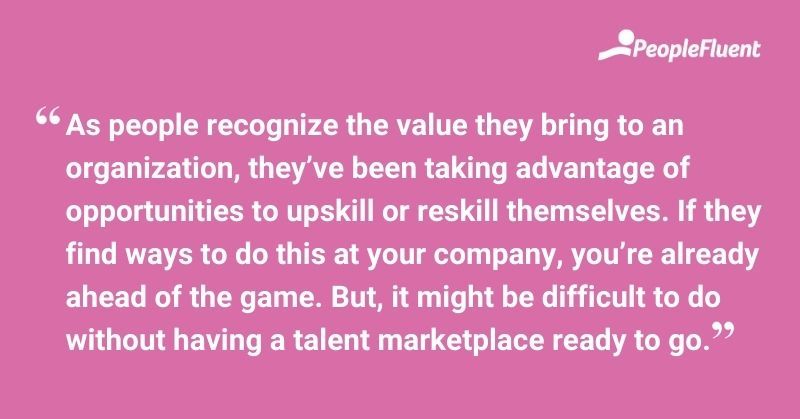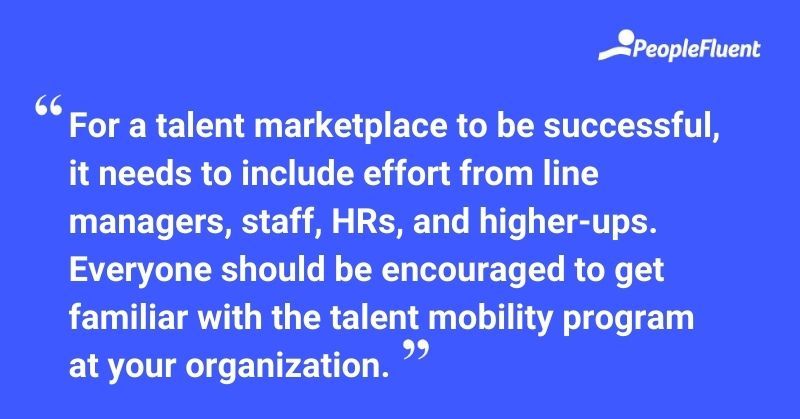Published: Jan 21, 2022Time to read: 6mins Category: Insights
Surviving The Great Resignation: How Talent Mobility Tech Can Help Build a Future-Proof Talent Marketplace
Table of Contents
You can’t know the future, but you can plan for it. Talent needs and strategies continue to shift at most companies. When we think about how this impacts recruiting, we have to consider the shortage of available talent. If you’re wondering how you can fill empty roles or gaps at your company, Josh Bersin recently expanded on these topics and shed more light on how companies can use technology to accelerate talent and career mobility within their workforces. Read on for more of these thoughts.
In recent years, we’ve seen how the HR tech landscape has evolved. With tools like talent mobility becoming more widely-used, companies are better equipped to get proactive about the recruiting challenges they face. As organizations work to digitize products and services—while also managing remote and hybrid workforces—the strain on many workers and businesses is even greater.
For instance, The Great Resignation has caused a large turnover in mid-level management. Some of the hardest-hit industries (such as healthcare) have struggled to keep staff from burning out, even offering larger bonuses or incentives to retain and attract talent. In fact, Bersin’s research shows that employee burnout spiked in March 2021 and has continued to climb ever since.
So, as candidate pools shrink and talent becomes more difficult to secure, how can you pivot? For starters, consider ways you can create a talent marketplace that fits the future outlook of your workforce.
YOU MIGHT ALSO LIKE | ‘Talent Mobility Tools Comparison 2021: Evaluating 5 Major Platforms’
Why Do I Need a Talent Marketplace?
A talent marketplace (also referred to as a talent mobility or internal mobility platform) is an important piece of tech that enables HR professionals to identify and move talent around the business. The key part is finding where the internal talent exists at your company and how these folks can use their skills to fill gaps around the business. Further, it even allows employees to do their own research and find open roles that may fit a lateral move they want to make in the company.
The talent marketplace has evolved from what was, historically, a career development/pathing solution. In its current state, a talent marketplace should allow you to build and implement career models and reinforce internal career growth. This can be done through project, gig, and agile work programs or practices. Essentially, it’s become an employee development portal where people can access coaching, development, mentorship, and skills analysis.
To answer the question of why you need a marketplace, it’s important to first understand your current and future goals. If you’re short on staffers now, consider this: the worker shortage issue isn’t going away anytime soon. As people recognize the value they bring to an organization, they’ve been taking advantage of opportunities to upskill or reskill themselves. If they find ways to do this at your company, you’re already ahead of the game. But here’s the thing: it might be difficult to do without having a talent marketplace ready to go.

Building Your Talent Marketplace
In his article from 2020, Bersin explores the stages of talent mobility tech’s evolution. You can read more about that in the full article, but it’s important to note here for a few reasons. As we’re now looking at Bersin’s third stage of talent mobility tech, HR pros and talent managers have the ability to be agile. That means using a new model for building your marketplace to include a diverse group of talent. Not only will this approach require planning and flexibility, but it’ll also require involvement from individual workers.
Employees can access endless opportunities—be it stretch projects, temporary roles to help other teams in the business, or even promotions. This agile approach, though, is more focused on gig and project-oriented work. It allows staff to move around different departments or teams, helping the business reach goals much quicker. It’s also a great way to offer learning in the flow of work, another way for people to upskill and reskill while they support other business efforts.
For a talent marketplace to be successful, it needs to include effort from line managers, staff, HR practitioners, and higher-ups. Everyone should be encouraged to get familiar with the talent mobility program at your organization. Workforce analytics can help with this by creating silos to help you organize and break down which skills your organization has, which ones are needed, and which employees want to develop themselves for the future. This data can also help you identify best-fit talent for open tasks or projects.
Ultimately, we believe that a talent marketplace should seamlessly integrate your recruiting, performance, learning process, and learning tech. Employees should have access to job portals that are customized based on their skills and career goals. This allows people to personalize the talent journey they’ll have throughout their time at your organization. And, the self-service component allows them to take control of their career path by accessing mentorship programs (through a mentors marketplace) and learning opportunities.
KEEP READING | ‘The State of Internal Mobility: 6 Emerging Trends for 2022’
Which Challenges Can You Address With a Talent Marketplace?
There’s a big link between talent mobility and increasing employee engagement. That’s because of the direct link between employee engagement and productivity, which makes complete sense. After all, when someone is passionate about the work they do, they’re more likely to engage with it.
So, let’s say Jim, a learning designer, wants to upskill himself but doesn’t have the opportunity to do so within his current role. You can offer Jim open tasks or projects that are related to his skills, career goals, and passion. This naturally offers itself to the reskilling initiatives your L&D teams might have. We know it can be tough to get people excited about learning and development when they’re focused on their own emotional wellbeing, other personal issues, and (of course) getting their daily workload completed. With a talent marketplace, people can find ways to help the company fill skill gaps, work with agility, and reskill themselves all at once.
Lastly, you’ll reduce your recruiting costs when you’re working from an internal candidate pool. If you’re able to fill permanent roles with internal staff, even better (and even more savings). Consider this: if a company with 10,000 employees has a 6% voluntary turnover rate, they’ll spend upwards of $45 million in annual recruitment costs.

MORE FROM THE BLOG | ‘Team Me Up, Scotty! 4 Ways Talent Mobility Can Create an Out-of-This-World Employee Experience’
Ready for more insights on how to future-proof your organization?
To learn more about the many ways a talent marketplace can help you create better processes, fill skill gaps, and future-proof your company, listen to a recording of the recent webinar, ‘Building a Talent Marketplace for the Future with Josh Bersin’. Alternatively, get in touch to see how PeopleFluent can help.